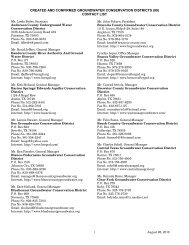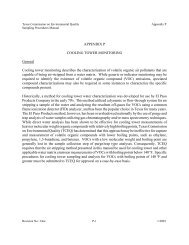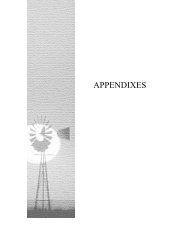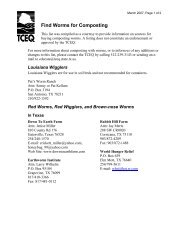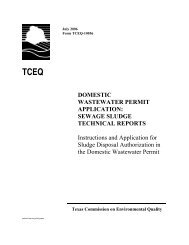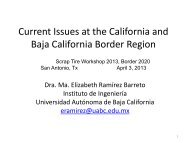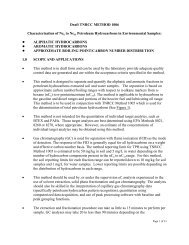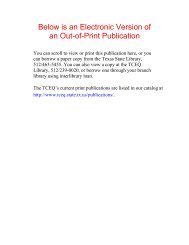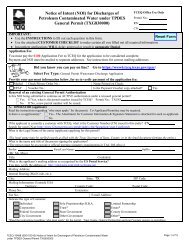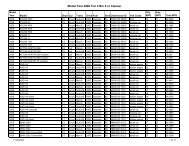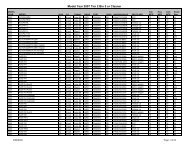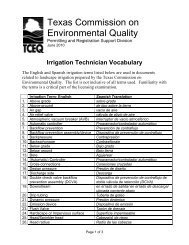Vinyl Chloride - Texas Commission on Environmental Quality
Vinyl Chloride - Texas Commission on Environmental Quality
Vinyl Chloride - Texas Commission on Environmental Quality
You also want an ePaper? Increase the reach of your titles
YUMPU automatically turns print PDFs into web optimized ePapers that Google loves.
<str<strong>on</strong>g>Vinyl</str<strong>on</strong>g> chloride<br />
Page 24<br />
exposure. The incidence of mammary gland carcinoma was higher in 2- or 8-m<strong>on</strong>th-old hamsters exposed<br />
to 200 ppm VC for 6 m<strong>on</strong>ths than in 14- or 20-m<strong>on</strong>th-old hamsters. Overall, exposures of equal durati<strong>on</strong><br />
were most effective in producing cancer when started early in life.<br />
Mechanistic studies are c<strong>on</strong>sistent with tumor studies. Laib et al. (1979) reported that VC induced<br />
preneoplastic foci in newborn rats but not adult rats. This effect was determined to be a result of the<br />
increased rate of cell proliferati<strong>on</strong> in newborn animals. Laib et al. (1989) reported that inhaled,<br />
radiolabeled VC was incorporated into physiological purines of 11-day-old rats eight times more than in<br />
adult rats, reflecting the higher degree of DNA replicati<strong>on</strong> activity in younger animals. In the same study,<br />
approximately five-fold higher levels of a DNA adduct (7-N-(2-oxyethyl)guanine) were found in the<br />
livers of young animals compared to adult animals, reflecting a higher alkylati<strong>on</strong> rate in younger animals.<br />
Similarly, Fedtke et al. (1990) reported an increased alkylati<strong>on</strong> rate in preweanling rats exposed to VC<br />
compared to adults. Ciroussel et al. (1990) reported a six-fold increase in the formati<strong>on</strong> of<br />
ethen<strong>on</strong>ucleosides in immature rats compared to adults. Similarly, Morinello et al. (2002) reported a two-<br />
to three-fold increase in the c<strong>on</strong>centrati<strong>on</strong> of ethenoguanine adducts in weanling rats compared to adults<br />
exposed to the same dose for the same time period.<br />
USEPA (2000) incorporated informati<strong>on</strong> from these studies into the development of a two-fold<br />
adjustment factor for early-life exposure to VC (see USEPA 2000 for a complete explanati<strong>on</strong> of how this<br />
factor was derived). Since the USEPA (2000) evaluati<strong>on</strong> was published, a PBPK model was developed by<br />
Clewell et al. (2004) to evaluate the potential age- and gender-specific pharmacokinetic differences <strong>on</strong> the<br />
dosimetry of VC. In this model, the rate of metabolite producti<strong>on</strong> per volume of liver was estimated to<br />
rise rapidly from birth until about age 16, after which it remains relatively c<strong>on</strong>stant before rising again<br />
later in life. The rate of metabolite producti<strong>on</strong> per volume of liver (the dose metric used in the cancer risk<br />
assessments for VC by Clewell et al. 2001 and USEPA 2000) varies four-fold from birth to 75 years of<br />
age, with peak values estimated in adolescence at age 14 to 16 and again later in life. Other factors that<br />
may affect VC toxicity early in life include the presence of fetal CYP450s, different levels of glutathi<strong>on</strong>e<br />
c<strong>on</strong>jugati<strong>on</strong> in developing animals, and differences in DNA repair capacity and other pharmacodynamic<br />
factors (ATSDR 2006). Although the results of this study provide support for the potential for early-life<br />
sensitivity to VC carcinogenicity, the authors did not intend for this informati<strong>on</strong> to be used quantitatively<br />
in risk assessments (Clewell et al. 2004). In the absence of more recent and definitive informati<strong>on</strong> to<br />
suggest the use of a different age-adjustment factor, the TD recommends the use of a two-fold ageadjustment<br />
factor as recommended by USEPA (2000) for early-life exposure. The exposure factor does<br />
not need to be applied if exposures <strong>on</strong>ly occur during adulthood. By applying the two-fold age-adjustment<br />
factor, the URF would be 8.4 x 10 -6 per μg/m 3 .<br />
4.2.6 Calculati<strong>on</strong> of Air C<strong>on</strong>centrati<strong>on</strong> at 1 x 10 -5 Excess Cancer Risk<br />
The 2005 USEPA Cancer Guidelines recommend the use of the LED10/linear method to develop cancer<br />
risk estimates for chemicals with a mutagenic MOA; therefore, the TD chose to use the URF of 4.2 x 10 -6<br />
per µg/m 3 (or 8.4 x 10 -6 per µg/m 3 corrected for an increased susceptibility of children) derived by<br />
USEPA (2000) using the LED10/linear method based <strong>on</strong> data from female rats (Malt<strong>on</strong>i et al. 1981 and<br />
1984). By using the inhalati<strong>on</strong> URF of 4.2 x 10 -6 per µg/m 3 , the chr<strong>on</strong>ic ESLlinear(c) for VC at the TCEQ no<br />
significant risk level of 1 x 10 -5 is calculated below:<br />
chr<strong>on</strong>ic ESLlinear(c) = [1 x 10 -5 ] / [4.2 x 10 -6 (µg/m 3 ) -1 ] = 2.4 µg/m 3 or 0.9 ppb<br />
The use of this value would be appropriate in situati<strong>on</strong>s in which you would not expect children to be<br />
exposed (possibly in an industrial envir<strong>on</strong>ment with no residential areas nearby).



